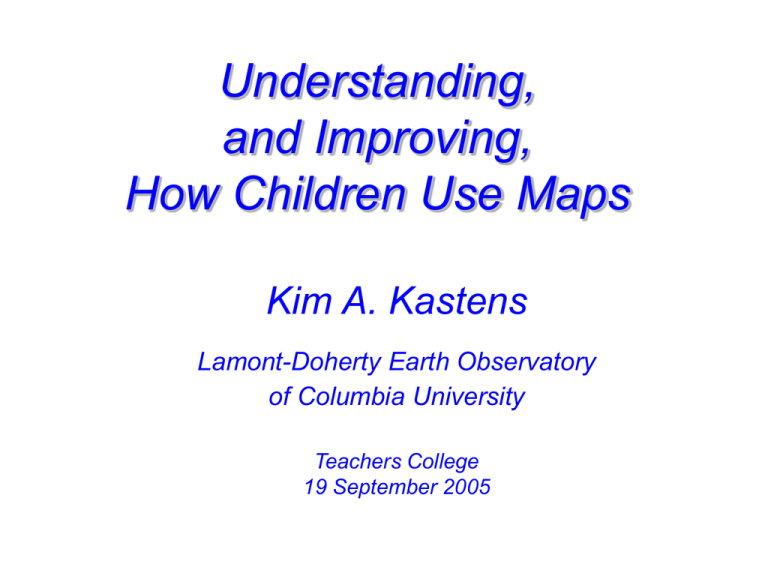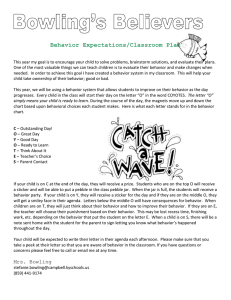Understanding, and Improving, How Children Use Maps
advertisement

Understanding, and Improving, How Children Use Maps Kim A. Kastens Lamont-Doherty Earth Observatory of Columbia University Teachers College 19 September 2005 from Kastens, K. A., Bonatti, E., Caress, D., Carrara, G., Dauteuil, O., Frueh-Green, G., Ligi, M. and Tartarotti, P., 2000. The Vema Transverse Ridge (Central Atlantic). Marine Geophysical Research. Knowing how to use a map is important for many jobs and careers. Knowing how to use a map is important for everyone who wants to be able to travel to new places. But for many people, including many adults, using a map to figure out where they are is very hard. Why is this so hard? And what can we do to help people learn this skill? Cartoon from: http://www.toothpastefordinner.com Today’s talk: • “Where are We?” software & curriculum • Generalized case: translation from reality to representation • Curriculum analysis: what’s not being taught • Field-based map skills project: what errors do children make with maps? A Tool for Understanding and Improving how Children Learn to Use Maps Generalization: a powerful use of learning technology Information received with senses Translation Representation on paper (or screen) Map-using is one case of a broader class of skills that involve translating from some perceived aspect of reality to a paper representation. Heard music Musical notation Perceived situation Mathematical representation Information received with senses Translation Representation on paper (or screen) Technology’s Roles: • set up numerous occasions where translation is required, numerous occasions to learn by trying. • Monitor and evaluate learner’s tries. • Provide feedback about quality of the learner’s tries. • Provide hints and suggestions when requested or needed. Curriculum Analysis: What is and is not being taught in elementary schools with respect to map skills? Frontispiece from Geography for Life: The National Geography Standards What’s wrong with this picture? Frontispiece from Geography for Life: The National Geography Standards What’s wrong with this picture? There is no school or classroom or teacher in this picture! Method for studying children’s understanding of spatial representation of place (after Liben, 1997) Production Method (after Frazee and Guardia, 1994) Method for studying children’s understanding of spatial representation of place (after Liben, 1997) Comprehension Method Line LineOrienteering Orienteering The student must follow a line drawn on her map. The location of the markers is not shown on the map, but if the line is followed correctly, the student will successfully intercept them. The markers may be small collectible items which the student can gather as she follows the line on the map, or the markers can present pieces of information which must be combined in a certain way to solve a puzzle or riddle. (after Garrett, 1996) (after Garrett, 1996) Method for studying children’s understanding of spatial representation of place (after Liben, 1997) Representational Correspondence method (words-map) Method for studying children’s understanding of spatial representation of place (after Liben, 1997) Production Comprehension Representational Correspondence Meta-Representational Instant Map Skills (2004) Instant map skills: US (2004) Number of student products in each category: Marvelous map activities (2002) Neighborhoods and C ommunities (2002) Reading Topographic Maps (2001) Reading maps (2001) C omic-Strip Map Skills (2001 Amazing Hands-on Map Activities (2001) Maps,Globes,Graphs (2000) The vast majority of activities in elementary school map skills materials are of one type: Representational Correspondence Great Map Games (2000) Mega-fun map skills (1998) Mapping Skills (1998) Mapmaking with children (1998) Great Map Mysteries (1997) Orienteering and map games (1996) Map Adventures (1995) Teach with Topographic Maps (1994) Maps and Navigation (1994) Maps and Globes (1994) Using maps in your community (1993) Around and about (1993) Mapworks (1992) Map C oloring Book (1992) Finding your way (1992) Exploring maps (1992) Beginning Map Skills (1990) Geography Skills (1988) Exploring our world (1988) Map Skills for Today (1986) Learning About Maps (1985) 0 10 20 30 40 Number of student products in category 50 60 70 Representational correspondence exercises are necessary but not sufficient to learn to use a map… ….. because they lack the crucial connection with reality, the represented space. Field-based investigations of children’s map skills The “Baseline” Group The “Baseline” Group SK A T PLACE (" CHILD REPRESE (ma The “Baseline” Group SK A T PLACE (" CHILD REPRESE (ma The “Baseline” Group “Put the blue sticker on the map to show where you think the blue flag is located….” The “Baseline” Group “Put the blue sticker on the map to show where you think the blue flag is located….” 2001-2002 and 2002-2003 classes (now 6th & 7th graders): The “Baseline” Group The “Baseline” Group Category 1 Error: Sticker is centered on a map object that resembles sticker in shape and size Correct Answer Type 1 Error Category 2 Error: Sticker is placed on symbol for grass, trees, or bushes; not on or adjacent to any built object Type 2 Error Correct Answer Category 3b Error: Sticker should have been adjacent to a road or path; placed instead on or adjacent to a structure Correct Answer Type 3b Error Category 4a Error: Sticker should have been on structure; placed on or adjacent to the wrong structure Correct Answer Type 4a Error Type 4a Error Category 5a Error: Sticker should be on structure; placed on correct structure but outside of “correct” ring Type 5a Errors Correct Answers Category 5b Error: Sticker should be adjacent to a road or path; placed on correct path or road segment, but outside the “correct” ring Correct Answer 5b Errors 2001-2002 and 2002-2003 classes (now 6th & 7th graders): The “Baseline” Group The “Baseline” Group Correct location is on a wall. Student stickers on the wrong building. Student sticker on the grass. Student sticker on trees or shrubs. Good student stickers. Percentage of stickers in each error category Error Group Error Number Baselin e 1 1.3 Representational 2 14.7 Correspondence 3a & 3b 6.3 4a & 4b 11.3 Configur ational Correspondence 5a & 5b 13.1 No Error No Error 53.4 All Representational Correspondence All Configur ational Correspondence All Errors 1, 2, 3a, & 3b 20.9 4a, 4b, 5a, & 5b 22.9 1, 2, 3a, 3b, 4a, 4b, 5a, & 5b 46.6 2001-2002 and 2002-2003 classes (now 6th & 7th graders): The “Baseline” Group The “Baseline” Group Result #1: Without instruction, many 4th graders (and some adults) find it difficult to accurately locate a realworld object onto a map. The “Explaining” Group Same as “Baseline”: SK A T PLACE ("reality") CHILD REPRESENTATION (map) Dependent Variable The “Explaining” Group Same as “Baseline”: Different: “After you put one of the stickers on the map, write down what clues you used to decide where to put the sticker…” SK A T PLACE ("reality") CHILD REPRESENTATION (map) Dependent Variable The “Explaining” Group The “Explaining” Group Result #2: Children who explained their reasoning did better than those who did not. Baseline Explaining Percentage of stickers in each error category Error Error Group Baselin e Reflecting Number No Error No Error 53.4 67.1 All 1, 2, 3a, & Representational 20.9 10.7 3b Correspondence All 4a, 4b, 5a, Configur ational 22.9 22.1 & 5b Correspondence Result #3: Among the “explaining” students, we see: • the explanation are accurate descriptions of reality, • there are many explanations that are insufficient to pinpoint the sticker, • there are many sticker placements that are wrong, but wrong in a way that is consistent with the corresponding explanation. Working hypothesis: the hard part about using a map in the real world lies in gathering the relevant information from the environment. Difficult Not so difficult The “Verbal Description” Group Same as “Baseline” and “Explaining”: The “Verbal Description” Group Same as Baseline and Explaining: Different: Verbal description read aloud in the classroom. “ The orange sticker is on the mansion. It’s on a corner of the mansion. It’s on the corner closest to the path that leads to the pond.” 2004-2005 class (now 4th graders): The “Verbal Description” Group Verbal description: • The orange sticker is on the mansion. • It’s on a corner of the mansion. • It’s on the corner closest to the path that leads to the pond. Exactly sufficient information, No more, no less. Result #4: The children who acquired information about the sticker position from a verbal description placed the stickers very accurately onto the map. Baseline Explaining Verbal Description Percentage of stickers in each error category Error Error Group Baselin e Reflecting Number No Error No Error 53.4 67.1 All 1, 2, 3a, & Representational 20.9 10.7 3b Correspondence All 4a, 4b, 5a, Configur ational 22.9 22.1 & 5b Correspondence Verbal Description 86.4 4.3 9.3 This supports our working hypothesis: the map itself is not that hard for children to work with; the hard part is identifying, gathering, and combining the relevant information from the environment. Difficult Not so difficult Representational Correspondence method Being able to translate from words to map and vice versa doesn’t mean a child can use a map competently within the represented space. Recap • “Where are We?” curriculum & software are designed to help children learn to “translate” from reality to map and vice versa. • Translating from perceived reality to a representation and vice versa is a powerful application of instructional technology. • Most map-skills curriculum materials under-emphasize making connections between maps and real world • Many children have difficulty locating themselves or a real world object on a realistically-complex map. • Metacognition improves children’s performance on a real world map-skills task. • The difficulty in map use lies in gathering task-relevant information from the represented space, not in positioning information from one’s mental model onto the map. • Ability to translate from a verbal representation to a map


